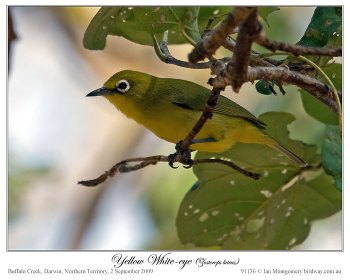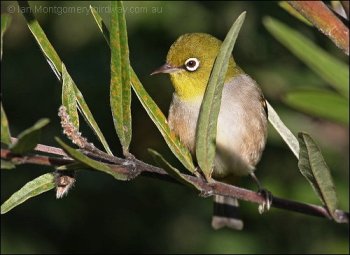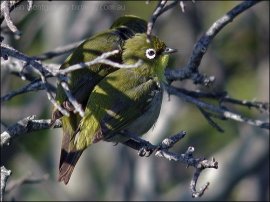
Oriental White-eye (Zosterops palpebrosus) ©WikiC
Oriental White-eye – The Grace Seeker.. ~ by a j mithra
The Oriental White-eye (Zosterops palpebrosus) is a small passerine bird in the white-eye family.
It is a resident breeder in open woodland in tropical Asia, east from the Indian Subcontinent to Southeast Asia, extending to Indonesia and Malaysia. They forage in small groups, feeding on nectar and small insects.
They are easily identified by the distinctive white eye-ring and overall yellowish upperparts. Several populations of this widespread species are named subspecies and some have distinctive variations in the extent and shades of yellows in their plumage.
This bird is small (about 8–9 cm long) with yellowish olive upper parts, a white eye ring, yellow throat and vent. The belly is whitish grey but may have yellow in some subspecies. The sexes look similar.
If we are called Christians, we need to look like Christ..
- But, do we look like Christ or do people see Christ in us and through us?
We have just stepped into a new year, where many of us would have taken resolutions to eat less, quit smoking, stop watching porn stuff and maybe a resolution to stop taking resolutions…
- But have we ever taken a resolution to walk like Christ, to talk like Christ and be like Christ?
People around us are watching us and expecting us to show Christ. You know?
Now is the time to take a resolution to be like Christ isn’t it?
For as many of you as have been baptized into Christ have put on Christ. (Galatians 3:27)

Japanese White-eye (Zosterops japonicus) by W Kwong
The species is widespread and is part of a superspecies complex that includes Zosterops japonicus, Zosterops meyeni and possibly others. The species is found in a wide range of habitats from scrub to moist forest.
They sometimes occur on mangrove areas such as in the Karachi area. and on islands they may lead a more insectivorous life. They are somewhat rare only in the drier desert regions of western India. A feral population was detected in San Diego, California in the 1980’s and subsequently eradicated.
These white-eyes are sociable, forming flocks which only separate on the approach of the breeding season. They are highly arboreal and only rarely descend to the ground.
God too expects us to be highly arboreal (living in a tree)..
- Adam tried to live on the tree of life but was chased away from God’s presence..
- We have a tree, the CROSS TREE, where Christ – the Vine hung to make us more like Him..
- Now is the time to check if we are Arboreal?
I am crucified with Christ: nevertheless I live; yet not I, but Christ lives in me: and the life which I now live in the flesh I live by the faith of the Son of God, who loved me, and gave himself for me. (Galatians 2:20)
The breeding season is February to September but April is the peak breeding season and the compact cup nest is a placed like a hammock on the fork of a branch. The nest is made of cobwebs, lichens and plant fibre.
The nest is built in about 4 days and the two pale blue eggs are laid within a couple of days of each other. The eggs hatch in about 10 days. Both sexes take care of brooding the chicks which fledge in about 10 days Though mainly insectivorous, the Oriental White-eye will also eat nectar and fruits of various kinds.
They call frequently as they forage and the usual contact call is a soft nasal cheer.
They pollinate flower when they visit them for flower insects (such asthrips) and possibly nectar that form their diet. The forehead is sometimes coloured by pollen leading to mistaken identifications.
- Do we visit Rose of Sharon and the Lilly of the valley every day and help in pollination?
- If yes, why is that people are not able to witness pollen grains (Word of God) on most of our foreheads?
Therefore shall you lay up these my words in your heart and in your soul, and bind them for a sign upon your hand, that they may be as frontlets between your eyes. (Deuteronomy 11:18)
When nesting, they may mob palm squirrels but being small birds they are usually on the defensive. Their predators include bats (esp. Megaderma lyra) and birds such as the White-throated Kingfisher. Like some other white-eyes, they sometimes steal nest material from the nests of other birds Cases of interspecific feeding have been noted with white-eyes feeding the chicks of a Paradise Flycatcher.
They have been observed bathing in dew accumulated on leaves.
- Do we remember, Israelites collected manna covered with the morning dew?
Which means feasting of Manna at dawn increases His grace in our life isn’t it? His grace is like early morning dew, this is what the Bible says right?
- Without His grace it is unlikely for us to survive..
It is of the LORD’S mercies that we are not consumed, because his compassions fail not. They are new every morning: great is thy faithfulness. (Lamentations 3:22-23)

Oriental White-eye (Zosterops palpebrosus) ©WikiC
Although not strong fliers, they are capable of dispersing in winds and storms to new areas including offshore islands. Though these birds are not strong fliers, they still are able to disperse in wind and storm..
- When we are weak , we need to remember that God uses the weak and the weary..
- When you face a storm is life, just think of these birds and disperse in the storm…
- For God always makes us lie down in green pastures and leads us beside still waters..
- What storm is for others will be still waters for you and me, cos our Lord is our good Shepherd!
Apostle Paul had a thorn in His flesh, you know what God said?
And he said unto me, My grace is sufficient for thee: for my strength is made perfect in weakness. Most gladly therefore will I rather glory in my infirmities, that the power of Christ may rest upon me (2 Corinthians 12:9)
Lets seek for His bountiful grace each dawn to fly high above troubled waters..
Have a grace filled day!
Yours in YESHUA,
a j mithra
Lee’s Addition:
Read more from a j mitha
The White-eyes are in the Zosteropidae – White-eyes Family.
*


























